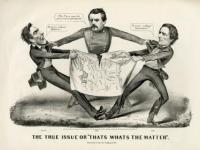Political cartoons are an excellent way to assess the popular culture of a particular time period. This lesson will combine history and language arts by asking students to examine various political cartoons in order to analyze point of view, symbolism, and irony. This lesson will also help students understand various historical events. Students are asked to use their critical thinking skills to make inferences about a particular illustration or text while gaining historical knowledge.
There are six political cartoons that highlight various topics and teachers are encouraged to pick and choose the ones that they feel will fit best with their social studies lessons. Also, HSP has hundreds of political cartoons so if you find that you would like to use more on a specific topic, feel free to contact us for a full list of age appropriate cartoons for your classroom.


